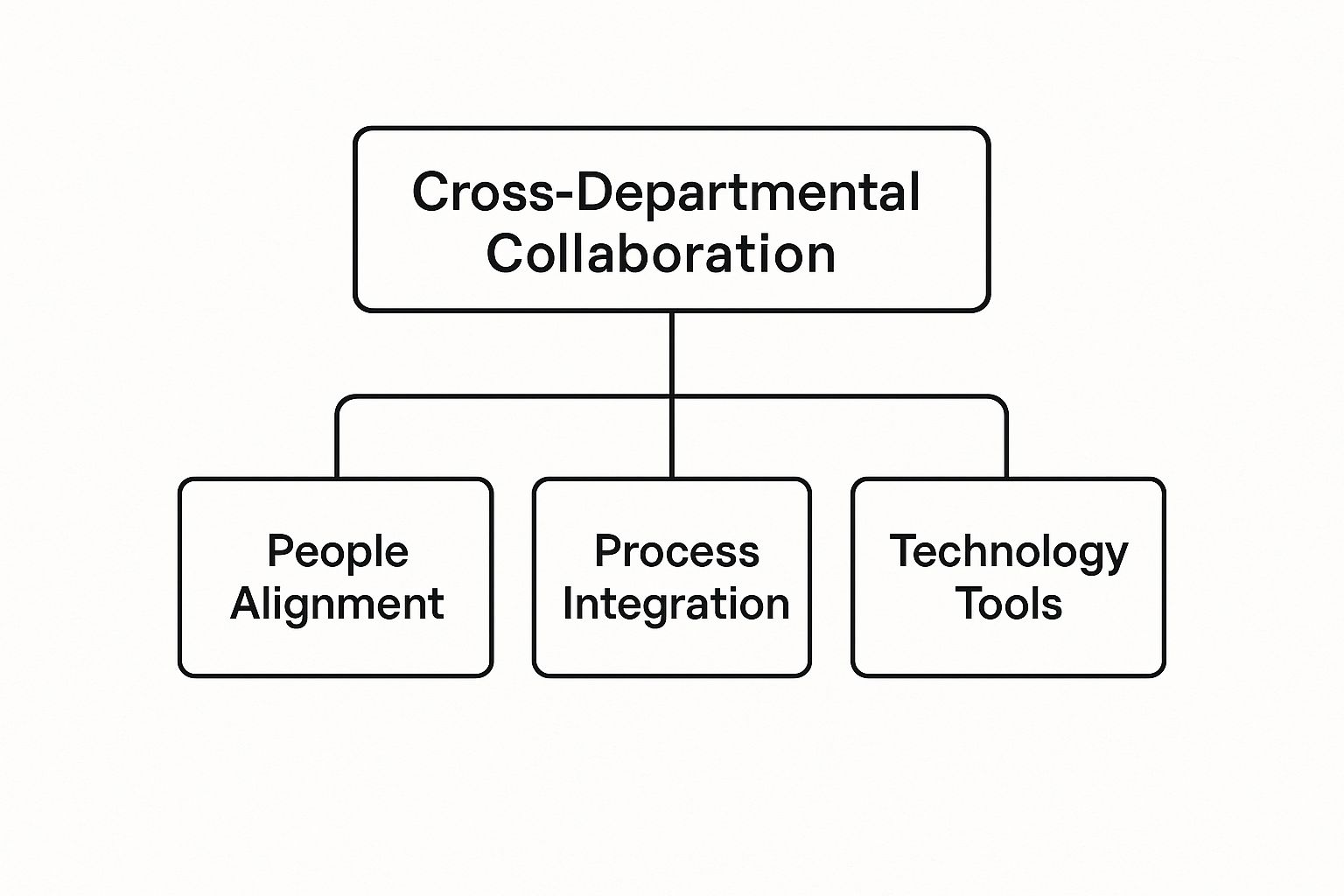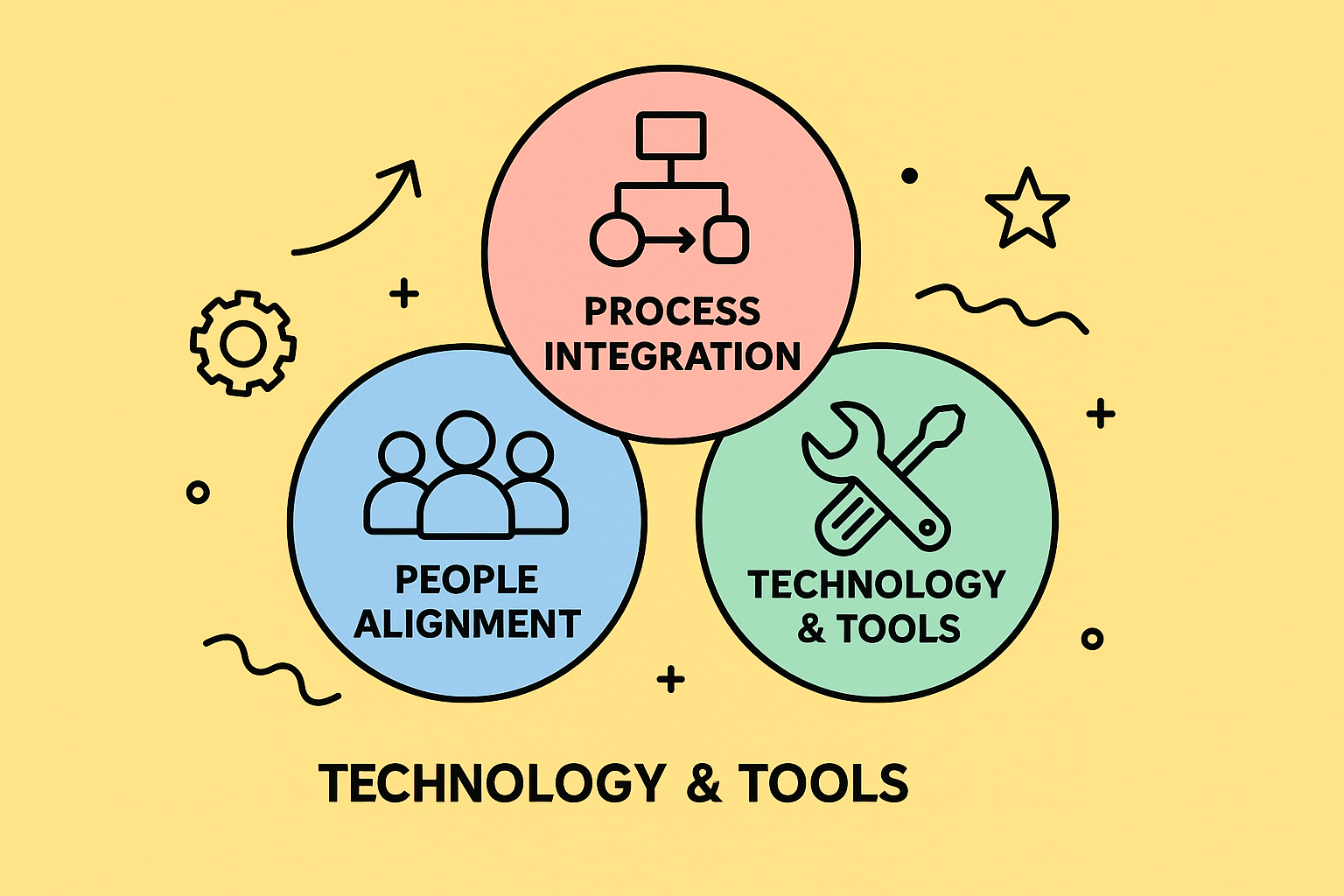At its core, cross-departmental collaboration is about getting teams from different corners of your business—like marketing, sales, and engineering—to work together on a shared goal. It’s the antidote to organizational “silos,” those invisible walls that spring up and keep teams working in total isolation. Breaking them down isn’t just a nice idea; it’s how you build a more cohesive and genuinely innovative company.
This kind of teamwork is what’s needed to tackle complex problems and really push the business forward.
What Is Cross-Departmental Collaboration, Really?
Think of your company as a world-class orchestra. Marketing has the violins, engineering holds the brass, and sales is on percussion. They’re all masters of their craft, but if they’re playing from different sheet music, you don’t get a symphony—you get a mess. Cross-departmental collaboration is the conductor’s baton, getting everyone to play in perfect harmony.
It’s about intentionally designing how your teams communicate and work together, allowing them to pool their unique skills, knowledge, and perspectives. When this clicks, a company stops being a collection of disconnected parts and starts acting like a single, powerful unit.
This isn’t just some feel-good corporate initiative; it’s a strategic must-have. In fact, a whopping 83% of companies worldwide actively use cross-functional teams. It’s clear this approach is becoming standard practice for any business that wants to stay competitive. You can dig into these collaboration trends to see why for yourself.
To better understand the shift, let’s compare the old way of working with the new collaborative model.
Siloed vs. Collaborative Teams Quick Comparison
This table shows the key differences in how siloed and collaborative teams operate and feel on a day-to-day basis.
| Characteristic | Siloed Teams (The Old Way) | Collaborative Teams (The New Way) |
|---|---|---|
| Communication | Formal, infrequent, often top-down | Open, frequent, multi-directional |
| Goals | Department-specific, often conflicting | Shared, aligned with company objectives |
| Knowledge | Hoarded within teams, “need-to-know” basis | Freely shared, accessible to all |
| Problem-Solving | Hand-offs, blame-shifting, slow resolution | Joint ownership, faster, more creative solutions |
| Innovation | Stifled by lack of diverse input | Fueled by a mix of different perspectives |
| Employee Mindset | “That’s not my job.” | “How can we solve this together?” |
| Outcomes | Inefficient, duplicated work, internal friction | Faster time-to-market, better products, higher morale |
The contrast is stark. Moving from a siloed structure to a collaborative one fundamentally changes how work gets done and how people feel about their contributions.
The Core Components of Collaboration
Great collaboration doesn’t just happen because you put people from different teams in the same meeting. It needs a solid foundation built on three key pillars: People, Processes, and Technology. Each one is critical to creating an environment where teamwork can actually thrive.
- People Alignment: This is the human side of the equation. It’s about setting shared goals that rise above departmental turf wars, building a culture of trust where people feel safe to speak up, and having leaders who genuinely champion a collaborative mindset.
- Process Integration: This is the operational backbone. It means creating clear, repeatable workflows and communication rules for projects that span multiple departments. Everyone needs to know how to engage with each other without causing chaos.
- Technology & Tools: This is what makes it all possible. It’s about having the right software and platforms—like monday.com and Jira—that connect teams, keep information in one place, and make it easy to see progress, no matter where someone works.
This simple diagram shows how these three pillars are interconnected.

As you can see, you can’t just focus on one piece of the puzzle. A successful strategy needs to balance the human, operational, and tech elements to create real change.
The goal is to move beyond simple cooperation—where teams work alongside each other—to true collaboration, where they work with each other, sharing ownership and responsibility for the final outcome.
This shift makes all the difference. When your product team gets direct insights from customer support, or when marketing truly understands the technical hurdles from engineering, the entire organization just moves smarter and faster. It’s the difference between a relay race, where you just pass the baton, and a soccer team, where everyone works together to score the winning goal.
The Undeniable Benefits of Breaking Down Silos
When teams finally decide to lower their drawbridges and start sharing what they know, something amazing happens. It’s about way more than just corporate buzzwords like ‘synergy.’ Getting cross-departmental collaboration right unlocks a whole treasure trove of real, tangible rewards that can seriously change your business for the better. You’re basically turning internal friction into an engine for growth.

One of the first things you’ll notice is a genuine surge in creativity and fresh ideas. Think about it: when you get an engineer, a marketer, and a support agent all looking at the same problem, they each bring a completely different angle to the table. That mix of expertise is where the magic happens, sparking ideas that just wouldn’t surface in a room full of people who all think the same way.
This naturally leads to solving problems faster and, frankly, building better products. For instance, when your customer support team can directly tell the product team about what’s frustrating users, bugs get squashed faster. Even better, future updates start to address what people actually need.
Boosting Efficiency and Morale
Improved efficiency is another huge win. When departments are actually talking to each other and aligning their efforts, you stop doing the same work twice. Marketing isn’t left building a campaign for a feature that engineering has secretly delayed, and sales isn’t out there promising something that doesn’t match the final product.
That kind of alignment does wonders for your team. People feel more connected to the bigger picture when they can see how their day-to-day tasks directly help other departments and contribute to a win you all share. It builds a much stronger company culture, one that’s genuinely based on trust and respect.
When employees from different departments share their knowledge and perspectives, they generate fresh ideas and uncover unique solutions to challenges. This exchange of insights leads to more dynamic problem-solving and imaginative strategies.
This kind of environment is also how you keep your best people around. When your employees get chances to learn from colleagues in different roles, they pick up new skills and get a much wider view of the business. That’s a massive driver for both engagement and retention. If you want to dig deeper into this, you might find our guide on how to break down silos effectively useful.
A Catalyst for Groundbreaking Innovation
Maybe the most powerful argument for this is how it can drive monumental innovation. Just look at Apple’s creation of the first iPhone, a project they called ‘Project Purple.’ That was a masterclass in high-stakes teamwork, bringing together hardware engineers, software developers, and designers into one cohesive unit. This intense, unified push resulted in a breakthrough product that went on to account for over 50% of Apple’s revenue.
And this kind of success isn’t just for the tech giants. The core benefits are the same for everyone:
- Faster Product Launches: Teams that are on the same page from day one can get from an idea to the market way more quickly.
- Increased Customer Loyalty: When you build products shaped by direct customer feedback, you end up with happier, more loyal users.
- Enhanced Adaptability: A connected organization is a nimble one. It can pivot and respond much more effectively when the market shifts or unexpected problems pop up.
At the end of the day, breaking down silos isn’t just a “nice-to-have” to make work feel better. It’s about building a more resilient, innovative, and successful organization from the inside out.
Common Collaboration Roadblocks and How to Bulldoze Them
If true cross-departmental collaboration is such a game-changer, why do so many companies trip up? Because genuine teamwork is messy. It pushes against the status quo and yanks people out of their comfortable routines. This isn’t just about getting people to be nicer to each other; you’re fighting against deeply ingrained habits and quirky organizational structures.
These hurdles are surprisingly predictable, yet they manage to derail well-meaning plans time and time again. The good news? Once you can put a name to the monsters hiding in the dark, you can figure out how to take them down.
The Communication Black Hole
The number one culprit behind collaboration trainwrecks is, you guessed it, a communication breakdown. Different departments might as well be speaking different languages. Marketing is all about MQLs and CAC, while engineering is deep in sprints and APIs. When these groups get in a room together without a shared dictionary, vital messages get lost in translation.
This isn’t just a feeling. While more than half of U.S. workers see teamwork as vital to their jobs, a whopping 41% of them say collaborating across departments is a massive headache compared to working with their own teammates. The primary reason? Those pesky communication gaps. You can dig into more stats about workplace collaboration challenges on 10xhire.io.
The Bulldozer Strategy: Build a simple, project-specific “communication playbook.” I’m not talking about a hundred-page novel no one will ever read. Make it a one-pager that defines key terms, clarifies who the point person is for what, and sets the ground rules for communication (like using Slack for quick questions and a weekly email for progress reports).
Conflicting Goals and Competing Priorities
Another classic roadblock pops up when departments have goals that are secretly fighting each other. Picture this: the marketing team gets high-fives for generating a massive number of leads (MQLs), but the sales team is only measured on high-quality leads that actually turn into paying customers (SQLs).
So, marketing hits its numbers by flooding the system with every possible prospect, leaving sales to waste hours sorting through junk. Both teams are technically “succeeding” by their own metrics, but the friction is killing the company’s bottom line. It creates a “zero-sum” game where one team’s victory feels like a loss for the other.
The Bulldozer Strategy: Before a single task is assigned, leadership needs to hammer out shared, project-based KPIs. Ditch the separate scorecards and create one big goal everyone is responsible for.
- Instead of: Marketing targets 1,000 MQLs and Sales targets 50 SQLs.
- Try: The joint team goal is to generate $100,000 in new revenue from this campaign. Both teams share ownership of the entire funnel.
This one tweak forces everyone to pull in the same direction, focusing on the real business outcome, not just their little piece of the pie.
Clashing Tech Stacks and Information Silos
Even with the best intentions, collaboration will grind to a halt if teams can’t easily share what they’re doing. What happens when your marketing team lives and breathes in monday.com but your developers are dug into Jira? Critical data gets locked away in separate digital fortresses. This tech divide leads to endless status meetings, mind-numbing manual data entry, and big decisions made with only half the story.
It’s the digital equivalent of trying to build a house when the blueprints are locked in two different safes that require incompatible keys. It’s frustrating, inefficient, and a huge barrier to smooth teamwork.
The Bulldozer Strategy: You don’t have to force everyone onto a single, one-size-fits-all platform. That’s a recipe for a revolt. Instead, build bridges between the tools they already know and love. Integrations, like the one connecting monday.com and Jira, act as translators, letting information flow freely between systems. This creates a single source of truth where anyone can see real-time progress without having to abandon the software they’re already an expert in.
Your Playbook for Seamless Collaboration

Theory is one thing, but results? That’s all about action. It’s time to move past the why and get our hands dirty with the how. Fostering true cross-departmental collaboration takes more than just good intentions—it demands a practical playbook.
These are the concrete best practices you can put into motion tomorrow, turning teamwork from a buzzword into a daily reality. The first step is to establish some crystal-clear “rules of engagement” for any project that crosses team lines. Without them, you’re just asking for chaos.
Establish Clear Goals and Roles
Before a single task is assigned, get everyone together—in a room or on a call—and agree on one crucial thing: what does success actually look like?
Don’t just set separate departmental goals. You need a single, shared objective that every single person is marching toward. This isn’t about marketing hitting a lead target while engineering ships a feature. It’s about the entire group achieving a business outcome, like boosting user sign-ups by 15%.
Once that north star is set, define roles with absolute precision. Who has the final say? Who’s the main point of contact for the marketing team? Who gives the final nod on the design? This simple exercise nips confusion in the bud and avoids that dreaded “I thought you were handling that” moment. For a deeper dive into getting teams on the same page, you can improve team collaboration with other proven strategies.
Appoint a Project Translator
Think of this person as the project’s diplomat. In any initiative spanning multiple departments, you desperately need a “translator”—someone who can act as a human bridge. Often, this is a project or product manager, but the title is far less important than the function.
This is the person who understands the languages, priorities, and pressures of each department. They ensure the technical limits explained by engineers are understood by marketing in terms of campaign timelines. They also make sure customer feedback from the support team reaches developers as actionable insights, not just complaints. This role is vital for keeping communication flowing and stopping minor misunderstandings from blowing up the whole project.
The most effective collaboration happens when you proactively remove friction. This means creating shared goals that unite teams and appointing leaders who can bridge the natural gaps in communication and priorities between departments.
One of the best ways to support this effort is by creating a robust internal knowledge base where key terms, project goals, and contact points are documented for everyone to see.
Foster Psychological Safety
You can have the best plans and processes in the world, but if people are afraid to speak up, collaboration is dead on arrival. Psychological safety is the absolute bedrock of effective teamwork. It’s that shared belief that you can ask a “dumb” question, challenge a sacred cow, or admit a mistake without being shamed or punished.
Leaders have to model this behavior. When a manager openly says, “I don’t know the answer to that,” or genuinely thanks someone for respectfully disagreeing, it sends a ripple of permission across the entire team.
Here are a few ways to build this safety net:
- Celebrate Questions: Actively encourage curiosity. Make it obvious that no question is off-limits or too basic.
- Embrace Productive Conflict: Frame disagreements as a healthy, necessary part of finding the best solution, not as personal attacks.
- Focus on Collective Wins: Ditch the “hero” culture. Shift the spotlight from individual rockstars to team accomplishments. Celebrate milestones together and, more importantly, analyze setbacks as a group, focusing on lessons learned instead of pointing fingers.
When you make it safe for people to be both vulnerable and curious, you unlock the full creative power of your cross-functional teams.
How To Bridge The Gap Between Business And Tech Teams

The image above nails it. A developer’s quick update in a Jira ticket instantly changes the status on the marketing team’s monday.com board. No meetings, no manual updates, just seamless visibility. That direct link is the secret to synchronizing teams that, let’s be honest, speak completely different languages at work.
Even with the best intentions, one gap always seems to be the hardest to cross: the one between your technical and business teams. This is where so many cross-departmental collaboration efforts slam into a brick wall. Your developers live and breathe inside the structured, ticket-driven universe of Jira. Meanwhile, your business teams—marketing, sales, support—are thriving in the visual, flexible world of monday.com.
This isn’t just about picking different software. It’s a fundamental difference in workflow, language, and even mindset. Forcing one team to use the other’s tool is a guaranteed recipe for frustration and mutiny. The real solution isn’t about forcing everyone into the same box; it’s about building a smart, technological bridge that lets each team stay where they do their best work.
This is where the right integration becomes your secret weapon.
The Integration As A Digital Translator
Think of the monday.com for Jira integration as a powerful Rosetta Stone for your entire company. It translates the technical details of a Jira ticket into a clear, visual status that makes perfect sense to your marketing team. And it works both ways.
It creates a true two-way street for information, which means nobody has to become a reluctant expert in a tool that just doesn’t fit their role. You can embed entire monday.com boards right inside a Jira issue or, conversely, create and edit Jira tickets without ever leaving your monday.com dashboard. Updates sync in real-time, creating a single source of truth that keeps everyone perfectly aligned without the hassle.
If you want to dig deeper into the mechanics of making this work, our guide on successful cross-functional team collaboration is a great place to start.
A Real-World Feature Launch Scenario
Let’s walk through a classic example: launching a new product feature. This is where marketing, sales, and development absolutely must be in sync.
Before Integration (The Struggle):
- The marketing manager is constantly pinging the product manager for status updates on the new feature.
- The product manager has to stop what they’re doing, check Jira, and then translate developer-speak into a simple progress report for the marketing team.
- A miscommunication happens, and the marketing team plans a big launch campaign for a feature that gets delayed. The result? Wasted effort, blown budgets, and a lot of internal friction.
After Integration (The Solution):
- A developer drags a Jira ticket from “In Progress” to “Ready for QA.” An automated rule instantly updates the corresponding task on the marketing campaign board in monday.com.
- The marketing manager sees the status change in real time, right on their own board, without ever having to log into Jira or ask for an update.
- The sales team checks that same monday.com board and knows exactly when they can start teasing the new feature to high-value prospects.
This seamless flow of information kills the need for constant status meetings and manual data entry. It frees up everyone to focus on their actual jobs, not on chasing down updates.
Life Before vs After The monday.com Jira Integration
The difference this kind of synchronized workflow makes isn’t small—it’s a fundamental shift in how your teams operate. It replaces the friction and guesswork with a smooth, automated flow of information.
Take a look at how things change.
| Challenge | Before Integration (The Struggle) | After Integration (The Solution) |
|---|---|---|
| Visibility | Business teams are totally blind to development progress without constantly asking for manual updates. | Real-time, automatic status updates appear directly where business teams work: in monday.com boards. |
| Communication | Endless status meetings and confusing email chains are needed to translate progress between teams. | Automated notifications and synced comments keep everyone in the loop without any extra effort. |
| Data Entry | Project managers burn hours manually copying and pasting information from Jira into monday.com spreadsheets. | A two-way sync eliminates all manual data entry, saving time and preventing human error. |
| Alignment | Marketing campaigns are frequently out of sync with actual development timelines, causing chaos. | A single, shared source of truth ensures everyone is working from the same up-to-date information. |
By bridging this critical gap, the integration does more than just connect two apps. It demolishes one of the most stubborn and frustrating silos in any organization. It empowers your teams to achieve genuine collaboration by giving them a common language of progress—all while letting them stay in the digital homes where they’re most productive.
Building a Culture That Lives and Breathes Collaboration
Let’s be honest. Tools are incredible, but they can’t do the heavy lifting all on their own. The slickest dashboards and most powerful integrations will eventually hit a wall if your company culture isn’t truly on board.
Building a real foundation for cross-departmental collaboration is about shifting mindsets. It’s about moving from “that’s not my job” to “how do we win this together?” This kind of lasting change has to be an inside job, built from the top down and the bottom up.
It all starts when leaders stop just talking about teamwork and actually start modeling it. When a C-suite executive openly pulls in another department head to crack a problem, it sends a powerful message across the entire organization. It shows everyone that sharing knowledge isn’t a sign of weakness—it’s the ultimate mark of strength.
Rewarding the Team, Not Just the Hero
One of the biggest, most impactful changes you can make is to rethink what, and who, you celebrate. So many companies accidentally sabotage collaboration by only rewarding individual heroics. When the solo achievement gets all the glory, it just encourages people to hoard information and protect their own turf.
To flip the script, you have to start rewarding collective wins. Did the marketing and product teams knock a feature launch out of the park, blowing past all the goals? Celebrate them together. This is how you nurture an environment where helping another department succeed is seen as a win for absolutely everyone.
Building a collaborative culture isn’t a one-and-done project. It’s a continuous process of nurturing trust and shared purpose. It means creating an environment where every single employee feels their contribution to the collective is valued far more than individual glory.
A strong foundation for this rests on clear, open lines of communication. Taking a look at key internal communication best practices can give you a roadmap to foster a more connected and transparent workforce where these ideas can really take root.
Embedding Collaboration into Your Company DNA
To make collaboration the default setting, it needs to be woven into the very fabric of your organization. This is where you get tactical and make it real.
Start with your hiring process. Make collaborative skills a non-negotiable competency in your job descriptions and a key focus during interviews. Don’t be afraid to ask candidates how they’ve handled disagreements with other teams or worked on projects that pushed them way outside their comfort zone.
Finally, think about the spaces where your teams interact, both physical and digital. Are they designed to spark spontaneous conversations and make sharing ideas effortless? When collaboration becomes a core part of your company’s identity, you’ll find that the whole process of collaborative work management becomes second nature for everyone involved.
Frequently Asked Questions
Still have a few questions buzzing around about making cross-departmental collaboration a reality? You’re not alone. Let’s tackle some of the most common ones to clear up any lingering confusion.
What’s The First Step I Should Take?
The single most important first step is to get everyone aiming at the same target. Before you even think about tools or new processes, get the leaders from the different departments in a room. Their mission? To agree on a single, measurable outcome for a small pilot project.
This immediately shifts the mindset from “my team’s metrics” to “our collective win.” It forces everyone to ask, “How do we get this done together?” rather than just guarding their own turf. Once you have that shared purpose, everything else falls into place much more easily.
How Can We Encourage Knowledge Sharing?
Knowledge hoarding is a huge, often invisible, barrier. To fight it, you have to make sharing not just easy, but rewarding. One of the best ways to do this is to create direct opportunities for people to learn from each other.
You could start with something simple like a mentorship program or have teams run peer-led training sessions. If you want to get more structured, our guide on how to cross-train employees has some great, practical steps for building a workforce where sharing what you know becomes second nature.
Don’t just tell people to share what they know; you have to build the moments for it to happen. Whether it’s workshops, an internal wiki, or even “lunch and learns,” making it part of the routine is the only way to truly break down those information silos.
What If We Face Strong Resistance From A Department?
Resistance is totally normal. It usually comes from a place of fear—fear of losing control, identity, or just being overwhelmed. The key is to directly answer the “What’s in it for me?” question.
Don’t try to force the change. Instead, show them how this collaboration actually makes them more valuable. Frame it as a way for their expertise to have a bigger impact across the company, not as something that will dilute it. Point out how working with other teams can help them crack their own stubborn problems faster. Kicking things off with a small, low-risk project is a great way to prove the benefits without it feeling like a massive, threatening change.
Ready to finally bridge the gap between your business and tech teams? With the resolution Reichert Network Solutions GmbH integration, you can connect monday.com and Jira to create a single, synchronized source of truth. Unify your teams, eliminate endless status meetings, and watch productivity soar.
